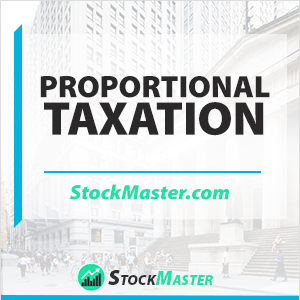 What is a Proportional Tax?
What is a Proportional Tax?
Definition: Proportional tax, also referred to as flat tax, is a tax system whereby the same percentage tax rate is levied across all income brackets. In this case, low, middle, and high-income taxpayers are often hit with the same tax rate. The tax system differs from progressive or marginal tax system where tax rates adjust accordingly depending on the taxable income.
A proportional tax system is based on the theory that everybody is equal, thus should be billed the same way. For example, if the rate is set at 10%, each taxpayer earning $100,000 or $50,000 or $500 will incur a tax bill equivalent to 10% of their income.
A sales tax is a good example of a proportionate tax as consumers are usually hit with the same tax bill on purchasing a given item. The tax system, in this case, does not take into consideration the amount of income that a consumer is looking to buy a given item earns. Conversely, proportionate tax applies to all goods and services on offer.
Proportionate Tax Pros
A proportionate tax system is often designed to create equality. Likewise, proponents insist that the equal tax rate is the fairest. Since there are no exemptions, rules are easily understood. The calculation of the tax bill is also pretty easy.
In addition, a proportionate tax system encourages people to work hard and generate more money. By generating more money, an individual would be able to pay much less on tax given the fixed tax rate.
Proportional Tax Cons
A proportional tax is a regressive type of tax as it does not increase or decrease even with fluctuation of income. In this case, it does not increase when the income subject to taxation increases. Conversely, it does not decrease as the income subject to taxation decreases.
Likewise, a proportionate tax tends to be unfair to low-income earners compared to high-income earners. Opponents of the tax system have always insisted that poorer taxpayers should incur much less compared to high-income earners. Therefore the system tends to place more burden on middle-income earners as they tend to carry a large portion of the government spending
The tax system also places more burden on low and middle-income earners as it eliminates deductions and increases the tax base to include even people who earn much less. Similarly, the system shifts the tax burden from the wealthy to the poor.
Proportional tax vs Progressive tax vs Regressive Tax
Proportional tax differs from the other types of taxes on the fact that a fixed tax rate is imposed on any taxable income. Likewise, the amount of tax is proportional to the amount subject to tax.
Regressive tax, on the other hand, is a type of system whereby the average tax rate decrease as the taxable amount increases. In this type of system, high-income earners tend to pay less on their taxable income, given the reduction on tax rate. The system, therefore, tends to create more burdens on low and middle-income earners, given the inverse relation between the tax rate and the income earned.
A regressive tax system tends to increase the incentive to work and create more wealth, given the expected lower tax rate on a higher taxable income.
A progressive tax, on the other hand, is a system whereby the tax rate increase as the taxable base increases. In this case, the tax rate increases from low to high as taxable income increases. Such systems are often deployed to reduce the taxation burden on middle and lower-income earners. Therefore a progressive tax system is the opposite of the regressive tax system. A progressive tax system reduces the incentive to work given the potential risk of a higher tax burden on earning more.
Summary
A proportional tax is simply a flat tax whereby the percentage of tax remains the same regardless of the taxable income increasing or decreasing.
